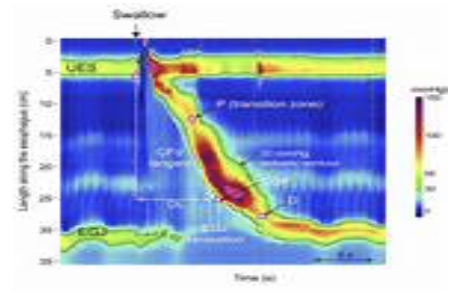{{ Interface.PageTitle }}
Motility Studies
High resolution manometry (HRM) to evaluate the upper GI tract.
HRM is used to assess the function of esophagus (food pipe). Manometry measures the strength and co-ordination of the contractions in the oesophagus during swallow. Usually performed for the following reasons:
- Difficulty in swallowing
- Heartburn/reflux
- Chest pain

How to prepare for HRM
Overnight fast or fasting for 6 hours is required prior to HRM. Local anaesthesia will be sprayed into the nostril and throat prior to insertion of the catheter.
The catheter will be inserted through the nostril into the esophagus (food pipe) and a total of 10 wet swallows will be performed to assess the coordination of the swallow. The pressure curves during the swallow as shown above will be studied. The lower esophageal sphincter muscle will be identified so that placement of the pH catheter can be done during 24 hour pH impedance study (if patients require this to assess their reflux symptoms).
24 hour pH impedance study to evaluate reflux disease
Reflux is common chronic condition that normally present with heartburn and regurgitation (sour and bitter taste in the mouth). It can also sometimes affect the sleeping pattern (interrupted sleep) and hence the wellbeing of patients. Conventional endoscopy can be normal in up to 70% of the patients. Hence the above test is used to measure the acidity within the food pipe and how frequently acid/non-acid is moving into your gullet from your stomach. It is used to investigate patients with persistent reflux symptoms despite taking acid suppression medications. Moreover, it is also used to evaluate patients with chest pain (not due to heart disease), atypical symptoms like chronic cough and hoarseness.
How to prepare
The impedance study is normally being carried out after the HRM investigation. The pH catheter will be in the esophagus (food pipe) for 24 hours. Dynamic information will be captured and recorded during the study. The acid exposure will be quantified and correlated to reflux events during the study.
What are the potential risks
The above procedures are relatively safe. The only potential risk is nose bleeding as the catheter is being inserted through the nostril. Sometimes some patients might experience gagging sensation during the insertion.
